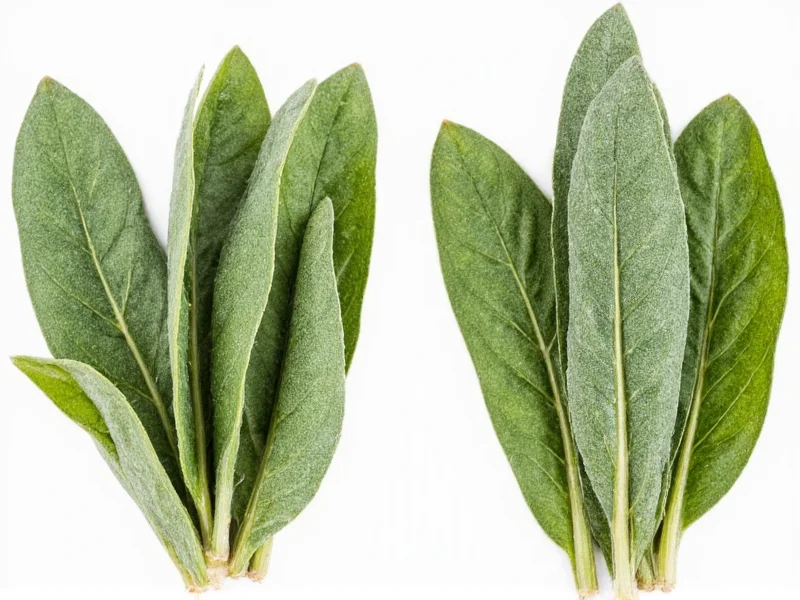The standard conversion ratio for fresh to dried sage is 3:1. This means if a recipe calls for 1 tablespoon of fresh sage, you should use 1 teaspoon of dried sage. Dried sage is more concentrated because the drying process removes moisture while preserving the essential oils that give sage its distinctive flavor and aroma.
Understanding herb conversions is essential for successful cooking and baking. When substituting dried sage for fresh in recipes, getting the measurements right can mean the difference between a perfectly seasoned dish and an overpowering culinary mistake. This guide provides accurate conversion information backed by culinary science and professional cooking experience.
Why Fresh and Dried Sage Have Different Potencies
Sage, like most herbs, undergoes significant chemical changes during the drying process. Fresh sage contains approximately 85% water, which evaporates when dried. What remains is a more concentrated form of the essential oils and compounds that give sage its distinctive earthy, slightly peppery flavor.
The concentration effect explains why you need less dried sage than fresh. Professional chefs and food scientists consistently confirm the 3:1 ratio as the standard conversion for most woody herbs like sage, rosemary, and thyme. This ratio accounts for both the moisture loss and the intensified flavor profile of dried herbs.
Complete Fresh to Dried Sage Conversion Chart
| Fresh Sage | Dried Sage | Common Recipe Application |
|---|---|---|
| 3 teaspoons (1 tablespoon) | 1 teaspoon | Soups, stews, meat rubs |
| 1 tablespoon | 1/3 tablespoon (1 teaspoon) | Sauces and gravies |
| 2 tablespoons | 2 teaspoons | Stuffing recipes |
| 1/4 cup | 1.33 tablespoons | Large batch cooking |
| 1/2 cup | 2.67 tablespoons (1/8 cup + 2/3 tbsp) | Holiday recipes |
| 1 cup | 1/3 cup | Commercial food preparation |
Practical Application in Cooking
When adapting recipes that call for fresh sage to use dried sage instead, consider these practical tips for best results:
- Timing matters: Add dried sage earlier in the cooking process than fresh sage, as it needs time to rehydrate and release its flavors
- Start conservatively: Especially with dried sage, which has a more intense flavor, begin with slightly less than the conversion ratio suggests, then adjust to taste
- Crush before using: Rub dried sage between your fingers before adding to release more essential oils
- Consider the dish type: For delicate dishes like custards or light sauces, use slightly less dried sage than the standard ratio
Understanding Flavor Differences Between Fresh and Dried Sage
While the 3:1 conversion ratio works well for most recipes, it's important to recognize that fresh and dried sage don't have identical flavor profiles. Fresh sage offers brighter, more citrusy notes with a subtle menthol quality, while dried sage develops deeper, more earthy characteristics with hints of pepper and eucalyptus.
For dishes where sage is the star ingredient—like classic Thanksgiving stuffing or brown butter sage sauce—the flavor difference might be noticeable. In these cases, consider these adjustments:
- When making brown butter sage sauce, use 25% less dried sage than the standard conversion
- For stuffing recipes, add dried sage at the beginning of cooking to allow full flavor development
- When using dried sage in creamy sauces, let it steep for 5-10 minutes before removing the leaves
Storage Considerations for Maximum Flavor
Proper storage significantly impacts the potency of dried sage, which directly affects your conversion calculations. Dried sage stored improperly can lose up to 50% of its flavor within six months.
For optimal shelf life and consistent conversion results:
- Store dried sage in an airtight container away from light and heat
- Use within 6-12 months for best flavor (older sage may require slightly more for equivalent flavor)
- Test older dried sage by rubbing a small amount between your fingers—if the aroma is weak, increase the amount by 25%
- Never store dried herbs above the stove or near other heat sources
Common Conversion Mistakes to Avoid
Even experienced cooks sometimes make these errors when converting fresh sage to dried:
- Using equal measurements: Treating fresh and dried sage as interchangeable without conversion
- Overcompensating: Using more dried sage than needed because "it doesn't smell as strong"
- Ignoring recipe context: Not adjusting for the specific dish type or cooking method
- Using old dried herbs: Not accounting for diminished potency in older dried sage
Remember that the 3:1 ratio serves as a reliable starting point for most cooking applications involving sage to dried sage conversion, but always trust your palate and adjust as needed for your specific recipe and personal taste preferences.
Professional Chef Insights on Sage Conversion
Professional chefs emphasize that successful herb substitution requires understanding both the science and art of cooking. Chef Maria Rodriguez, with 25 years of culinary experience, notes: "The 3:1 ratio is technically correct, but in practice, I often use slightly less dried sage—more like 2.5:1—for delicate dishes. The key is understanding that dried herbs need time to rehydrate and release their flavors, so I always add them earlier in the cooking process."
This professional perspective highlights why understanding the principles behind fresh to dried sage conversion matters more than simply following a rigid formula. Context, cooking method, and personal taste preferences all play roles in determining the perfect amount for your specific application.











 浙公网安备
33010002000092号
浙公网安备
33010002000092号 浙B2-20120091-4
浙B2-20120091-4